[Artikel in Arbeit]
Inhalt
Siehe auch
WeiterlesenInfos und Anregungen zu "Im Ruhestand die Welt bereisen"
See https://www.petermeinl.de/about_me
Hier ein paar einfache Möglichkeiten, zum anonymer im Web Surfen und Werbetracking eindämmen:
Weiterlesen[Artikel in Arbeit]
– Anti anschwall prompt aufnehmen
KIs sind keine aufgepeppten Suchmaschinen, die vorhandene Ergebnisse finden und liefern. KIs generieren neue Antworten aus angelernten und zur Verfügung gestellten Informationen.
Weiterlesen[Artikel in Arbeit]
Hier meine Überlegungen und Erfahrungen zur konkreten Verbesserung digitaler Souveränität. Zur (politischen) Motivation siehe Digitale Souveränität
WeiterlesenSiehe auch:
– Die Steuer auf Renten ist in D gar nicht sooo hoch!
– Mythen und Fakten zur gesetzlichen Rentenversicherung (DRV)
– Null Steuer auf Rente in Thailand
– 5. Internationale Aspekte zur Finanzgestaltung im Ruhestand
Generell werden deutsche Renten auch ins Ausland ungekürzt ausgezahlt. Es gibt aber 2 Ausnahmen:
A journey is a person in itself. No two are alike. And all plans, safeguards, policies and coercion are fruitless. We find after years of struggle that we do not take a trip, a trip takes us. [John Steinbeck]
Oder wir bringen so viel von uns und unseren „Problemen“ mit, dass wir gar nichts Neues erleben…
Für ein umfangreiches Sammelsurium hilfreicher Infos, Tools und Websites zum Reisen siehe: Länder-Vergleiche Tools und Infos
In diesem Post gebe ich Infos zu vielen Orten, aber das soll nur ein Gefühl für potentielle Reiseziele geben – vielleicht ist der nächste (kleinere) Ort ja die bessere Wahl – also immer offen für Alternativen bleiben!
Hier ein sehr persönlicher Vergleich von Reisenden zu Philippinen vs. Malaysia. Das Video enthält viele interessante Wertungen und obwohl Malaysia nach Punkten gewinnt, würden beide vor die Wahl gestellt die nächsten 5J lieber in den Philippinen reisen.
sociabnb „Die neue Art, nachhalitig zu reisen“

Reddit \digitalnomad: European Recommendations for Comfortable Winter Living on £/$/€ 1000 per month?
Auf sowas wie Las Vegas habe ich auch keine Lust.
[ *) Diese Seite enthält Affiliate-Links. Das kostet dich nichts, bringt mir aber etwas Einkünfte.]
Ich nutze die elektronische Patientenakte (ePA) für meine Eltern und mich. In meiner Abwägung überwiegt der Nutzen für uns persönlich und für unser Gesundheitswesen eindeutig die potenziellen Risiken.
Ich bin sehr für die ePA, sowohl für Behandlungen als auch für Forschung. Die Freischaltung unterscheidet sich für gesetzlich (GKV) und privat Krankenversicherte (PKV):
Zur elektronischen Patientenakte habe ich einiges detailliert im Finanztip Forum geteilt
Habe meine ePA und Vertretungen für die ePA meiner Eltern in der TK-Safe App der Techniker GKV registriert. Das funktioniert gut. Die Apps der TK funktionieren für mich deutlich besser als die der DAK.
[Dieser Post enthält Amazon Affiliate-Links. Das kostet dich nichts, bringt mir aber etwas Einkünfte.]
Fürs Reisen kaufe ich immer ein zweites, möglichst kleines, Netzteil für den Notebook. Das große bleibt zu Hause, das kleine bleibt immer im Reiserucksack – so fehlt nie irgendwo eines, weil ich es einzupacken vergaß. Nur Original-Netzteile verwenden! In Asien kann man Fakes kaum von Originalen unterscheiden – wäre ich nicht zufällig daneben gesessen, dann hätte so ein Fake mein Hotelzimmer abgefackelt, als sein Netzkabel zu brennen anfing.
Hier ein kleines, flaches, 235g leichtes, günstiges 65 Watt Reisenetzteil Lenovo ThinkPad Slim 65W AC Adapter USB-C(*). Wegen der relativ langen Kabel auf beiden Seiten des Netzteils ist es besonders gut zum Arbeiten mit Notebooks geeignet: Man kommt ohne Möbelrücken an die meisten Tische und der Stecker rutscht nicht aus wackeligen Steckdosen, weil das Netzteil nicht daran zieht, sondern auf dem Boden liegt.
Es hat ausreichend Leistung, meinen ThinkPad auch durch ein USB‑C‑Hub zu laden – solche Hubs verschlucken ca. 15 Watt. Bei schwächeren Netzteilen an einem Hub melden die Notebooks ein inkompatibles Ladegerät. Leider gibt es selbst in den USA keine Version davon mit 2-poligem Stecker. Aber mit einem 3-poligen Kabel mit US-Stecker(*) lässt es sich universal nutzen.
Aktuell nutze ich als Reisenetzteil das sehr kleine, 150g leichte Anker Prime 67W USB-C GaN Ladegerät 3 Ports(*) mit dem langen, sehr flexiblen Anker Powerline III Flow USB-C Ladekabel(*).

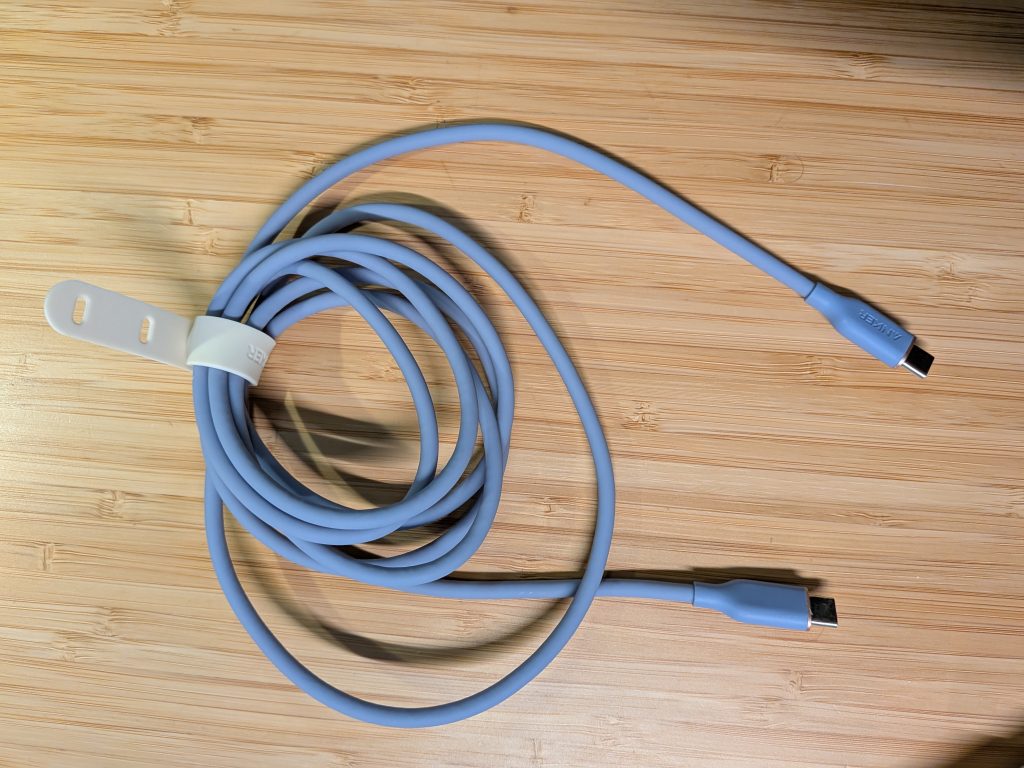
Es lädt mein Thinkpad X1 Tablet auch durch einen USB-Hub (welches ja ca. 15W verschluckt) – dazu darf aber weder ein Handy am 2. USB-C Steckplatz geladen werden noch z.B. eine Maus am USB-A Steckplatz. Mit am Hub angeschlossener Maus laden sowohl Maus als auch Notebook. Sind Notebook, Handy und Maus gleichzeitig direkt an das Ladegerät angeschlossen, dann laden alle 3 problemlos gleichzeitig. Das alles funktioniert auch mit langem USB-C-Kabel. Es gibt Versionen dieses Reisenetzteils mit höherer Ladeleistung. Somit sind sehr vielfältige Einsatzmöglichkeiten gegeben (ähnlich den typischen, praktischen Kabellängen von Lenovo-Netzteilen).
Hier ein simples USB-C Hub (*), Leicht und klein, ohne Ethernet, aber mit langem Kabel, damit das Hub bei 2-in-1 Notebooks nicht in der Luft hängt.
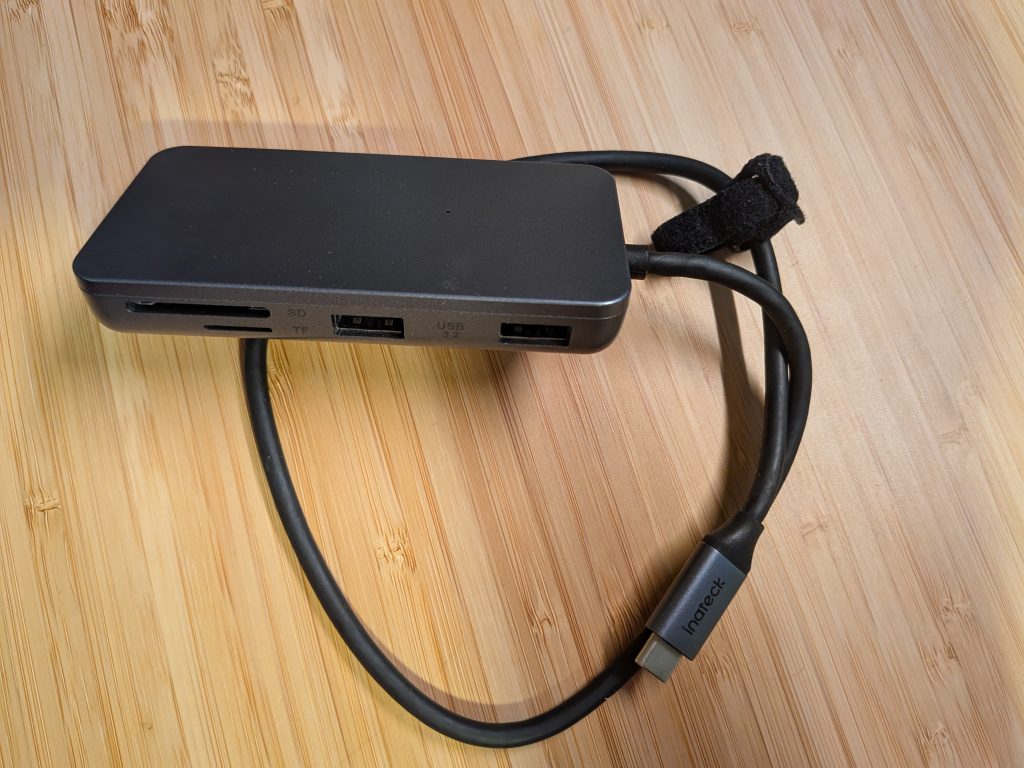
Inateck 7 in 1 USB C Hub (*) langes Kabel, kein LAN
Lenovo 150 USB-C Travel Dock (*) kurzes Kabel, hat LAN-Buchse
– Run your 4K monitors alongside USB devices from a single USB-C laptop port
– c’t Magazin: Docking-Stationen mit Thunderbolt 4 und USB-C
Mein Kabelsalat mit Netzkabel-Spinne, Netzteil und Hub ist nicht schön, aber funktional, sehr flexibel, kompakt und leicht, siehe auch Meine Packlisten zum Reisen.
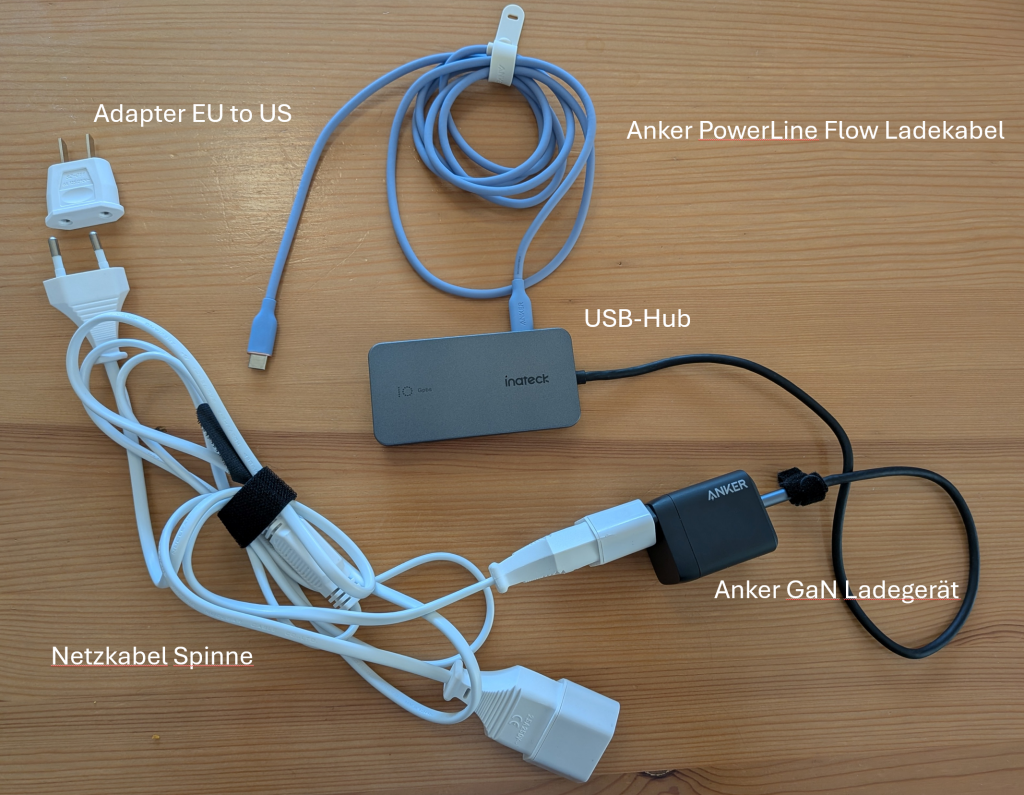
Hier noch einige gute Teile:
Zu Steckdosen-Adaptern gibt es einige Möglichkeiten: Multi-Klötze wie der von SKROSS, Reise-Steckdosenleisten wie die ZBRAIN oder Kabel mit lokalen Steckern, Mir sind die Adapter-Klötze zu unhandlich und an den oft wackeligen Steckdosen in Unterkünften zu unsicher. Steckdosenleisten sind auch klobig, aber sicherer.
Reiseadapter US to EU(*)
Reiseadapter EU to US(*)
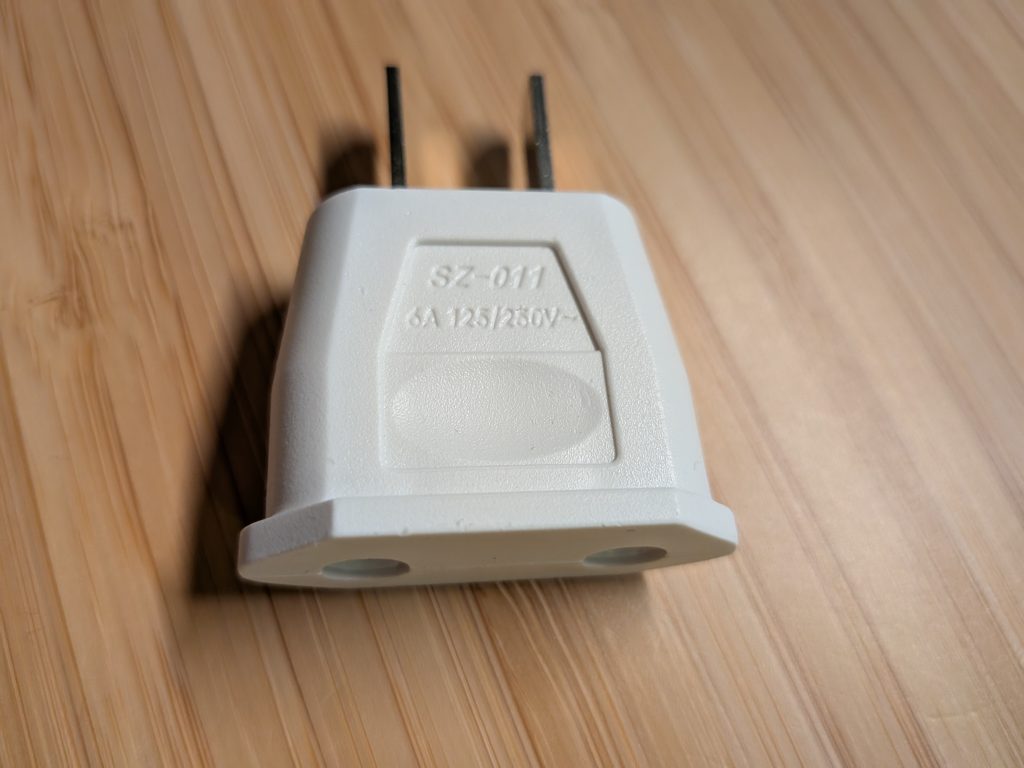
ZBRAIN Reise-Steckdosenleiste USB mit Reiseadapter, Mehrfachsteckdose 2 fach 4 USB(*)
SKROSS 1.3025 PRO World + USB – Reiseadapter inklusive USB-Ladeport(*)
Ist man länger an einem Ort mit ausländischen Netzsteckertypen empfiehlt es sich Netzteilkabel mit lokalem Stecker zu besorgen – das ist nicht so ein Gefummel und Gewackel wie mit Adaptern.
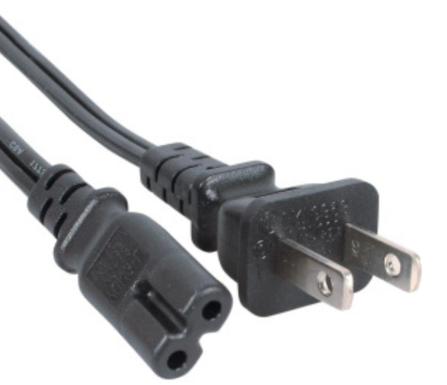
InLine 16654U Netzkabel, Netzstecker USA auf Euro 8 C7 Stecker (*)
InLine 16656U Netzkabel für Notebook, USA/Canada, 3pol Kupplung(*)
Stromkabel 2 Polig, RIKSOIN Netzkabel 1m Eurostecker (CEE 7/16 auf C7)(*)
Ich nutze Mehrfachstecker „Spinnen“ mit 2 und mehr Anschlüssen. Diese sind flexibel, leicht, kompakt (aber solide!) und die eingesteckten Stecker blockieren sich nicht gegenseitig. Man darf sie jedoch nicht mit zu leistungshungrigen Verbrauchern überlasten – ich habe jedenfalls keine Lust, irgendwo die Hütte abzufackeln. Netzkabel mit ausländischem Stecker, einzelne kleine Steckdosen-Adapter und Steckdosenleisten gibt es meist überall vor Ort.
Verlängerung Netzkabel, 2-in-1 Verlängerungskabel Typ-C-Stecker Eurostecker auf Euro Buchse kurz(*)
Verlängerung Netzkabel, 2-in-1 Verlängerungskabel Typ-C-Stecker Eurostecker auf Euro Buchse lang (*)
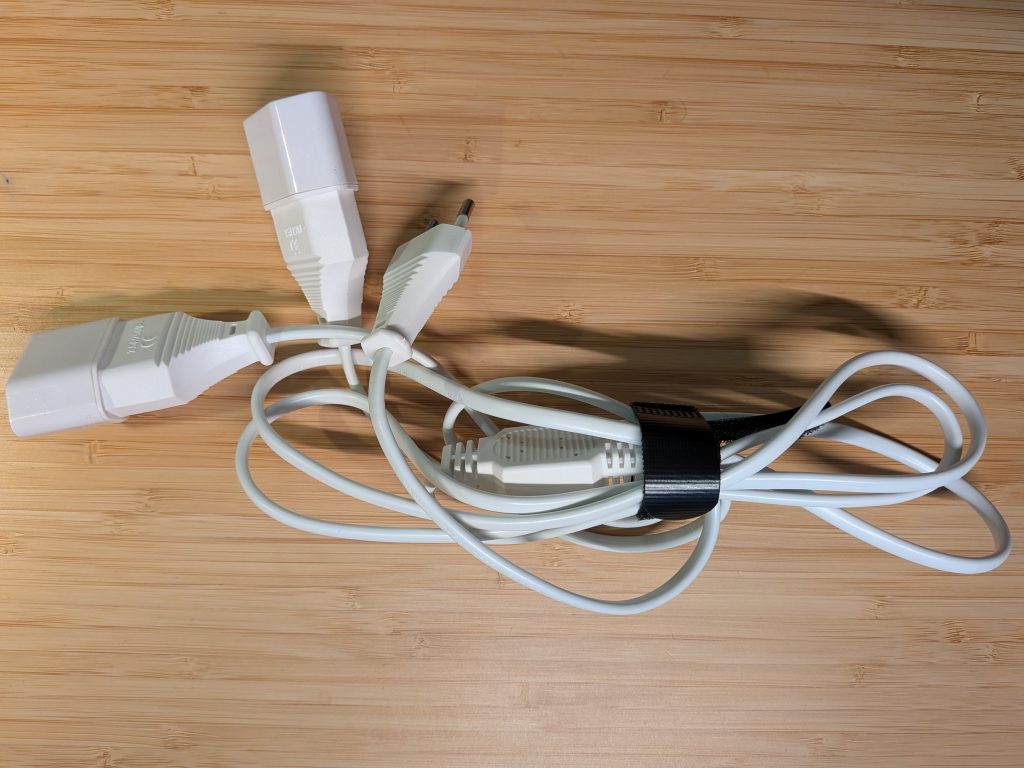
USB-C Magnetadapter(*), damit man beim übers Kabel stolpern das Notebook nicht vom Tisch reißt.
USB Datenblocker(*), als Kondom gegen Viren an öffentliche Ladestationen. Will das Laden damit nicht funktionieren, kann es helfen, den USB-C Stecker um 180° zu drehen. Alternativ kann man die Android USB-Standardeinstellung „Keine Datenübertragung“ konfigurieren.
[Dieser Post enthält Amazon Affiliate-Links. Das kostet dich nichts, bringt mir aber etwas Einkünfte.]
USB Datenblocker(*), als Kondom gegen Viren an öffentliche Ladestationen. Will das Laden damit nicht funktionieren, kann es helfen, den USB-C Stecker um 180° zu drehen. Alternativ kann man die Android USB-Standardeinstellung „Keine Datenübertragung“ konfigurieren.
Wer unterwegs viel mit dem Notebook-Screen arbeitet, braucht einen portablen Notebook-Ständer(*).
Für Leute mit Behinderungen gibt es z.B. von Microsoft adaptives Zubehör:

Mit dem Google Nest Mini Lautsprecher mit Google Assistant kann man nicht nur gut Nachrichten und akzeptabel Musik hören, sondern auch hands-free (oder ohne beim Aufwachen nachts erst die Brille aufsetzen zu müssen) nach Uhrzeit, Wetter und sonstwas fragen, Alarme einstellen und Sprachnotizen machen. Ist klein und leicht genug zum Reisen. Häufig gibt’s den fast umsonst. Mein wichtigstes Kommando: „Hey Google, stream Deutschlandfunk from TuneIn“.
Leider ist der Umgang seitens Google mit Softwareproblemen seiner Audio‑Geräte völlig unakzeptabel. Man muss bei Problemen einplanen, das Gerät ohne Ersatz wegwerfen zu müssen – was bei diesem Preis in Abwägung zum Ärgern zu verschmerzen ist. So wurde einer meiner Google Home Lautsprecher plötzlich unbenutzbar mit Meldung „… there was a Glitch…“ (dieses Problem haben viele Nutzer) und Google wehrte jeden Wunsch nach Reparatur oder Ersatz mit absurden Test-Vorschlägen ab. Beim selben Problem mit einem bei Amazon gekauften Google Nest Mini bekam ich in 2 Min einen QR-Code zur Rücksendung und Erstattung. Also, wenn möglich, besser bei Amazon kaufen.

Falls man keine Handy-Apps zur Autorisierung verwenden möchte, vgl. Digitale Souveränität: Der Reiner SCT(*) Karteleser funktioniert via Chip und NFC. Er ist kompatibel mit eGK (z.B. für die ePA Desktop Apps), ePerso (mit der Ausweis App) und Girocard (mit manchen Banking Apps). Er hat sogar Treiber für Windows on ARM. Funktioniert nicht am Handy.
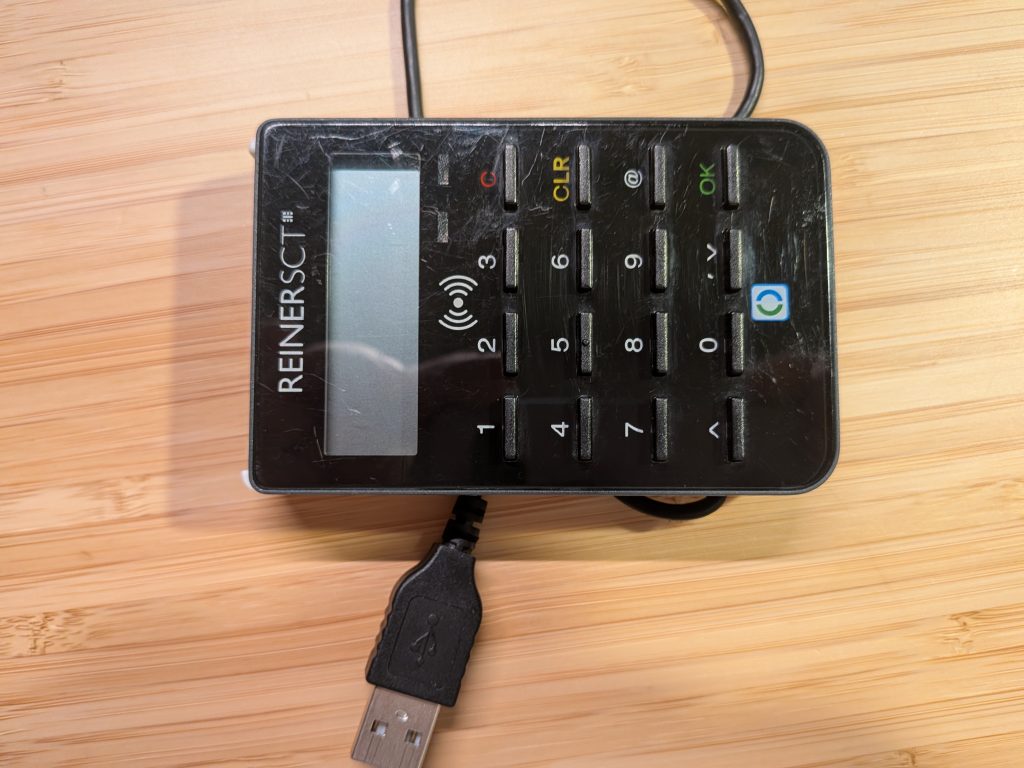
Zur Authentifizierung mittels ePerso via Ausweis-App nutze ich nur noch mein Handy als Lesegerät (via NFC). Leider wird die Authentifizierung mittels Perso bisher nur von wenigen Dienstleistern genutzt. Mit der DRV, Elster und der Agentur für Arbeit hat das bei mir aber gut funktioniert. Für die Authentifizierung mit den KV-Apps braucht man leider ein Kartenlesegerät(*). Der Reiner SCT hat sogar Treiber für Windows on ARM.
Ich mag die Samsung Galaxy Buds Live Earbuds(*). Diese sind halboffen, damit hört man seine Umwelt, und ich höre im Unterschied zu den dicht sitzenden Buds keinen Schrittschall beim Gehen. Der Klang ist völlig OK. Verständlichkeit für Angerufene beim Telefonieren ist gut. Nach ein paar Min vergisst man, dass man sie trägt.
Gegen Lärm im Flugzeug oder beim Arbeiten hilft der Bose Noise Cancelling Kopfhörer 700. Alle guten Noise-Cancelling Kopfhören sind recht teuer – aber für lange Flüge kann man sich einen gönnen. Die over-ear, wie der gute Bose Noise Cancelling Headphones 700(*), sind aber recht sperrig.
Wer’s kleiner mag, ist mit den Bose QuietComfort 20 in-ear(*) gut bedient. Der dämmt aber nicht so gut wie die over-ear-Version. Ist auch recht teuer.
Aktuell scheinen die Sony WF-1000XM5 in-ear(*) zum Reisen wohl am besten zu sein.
Siehe auch Android: Einstellungen, Sicherheit & Migration auf neues Handy
Für jemanden, der das Android-Ökosystem bevorzugt, empfehle ich Google Pixel Handys: sauberes Standard-Android, monatliche Sicherheitsupdates. 5G ist vorhanden, brauche ich selbst aber nicht. Das 5G, um welches es hier geht (mobile, cellular 5G) sollte man übrigens nicht mit WLAN (WiFi) 5G verwechseln.
Pixel Handys bieten neben einem aufgeräumten Standard-Android etliche exklusive Funktionen: Watch „20 Amazing Pixel Features that should come to EVERY Smartphone!“
Für Gebiete ohne Handy-Empfang gibt es kleine, bezahlbare SOS Satelliten-Kommunikationsgeräte wie das Garmin InReach(*). Damit lassen sich von überall auf der Welt Notrufe absetzen und Nachrichten per Zwei-Wege-SMS austauschen.
Dual-SIM ist mir fürs Reisen wichtig. Mein Pixel-Handy hat eSIM und einen SIM-Slot für eine physische SIM. Man kann auf einem Handy mehrere eSIMs gleichzeitig installieren und zwischen diesen wechseln, ohne sie jeweils neu aktivieren zu müssen. Siehe auch Telefonieren und Internet im Ausland
Meine Windows Phones waren die besten Handys, welche ich je hatte – aber leider wurde Windows Mobile von Microsoft eingestellt. Das Pixel 4a 5G war mein bestes Android-Handy bisher: genau die richtige Grösse und Gewicht.
Handys sind für den Alltag so wichtig, dass ich immer ein vorbereitetes Ersatzhandy habe. Aktuell habe ich zwei Google Pixel 9a (*). In Blau und Rot, damit ich sie nicht verwechsele. Bin damit voll zufrieden. Sie zeigen keinerlei schlechte Auffälligkeiten bei Mobiverbindung, Akkuverbrauch oder Aufheizung.
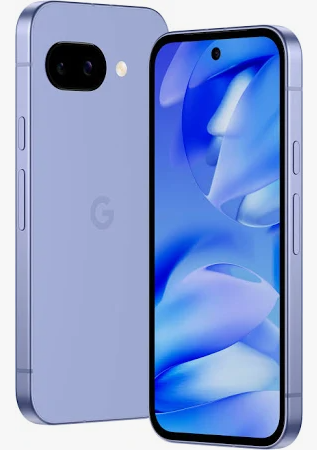
Zum Abstellen: Ikea Bambus Halter für Handy / Tablet (*)
Die Helligkeit des 9a-Screens hilft beim Ablesen in der Sonne – manche Supermarkt-Scanner für Kundenbindungs-Apps mögen aber die strahlend hellen QR-Codes nicht lesen.
Unerwarteterweise ist das Entsperren mit der Kombination von under-Display-Fingerprint-Reader und Face-Unlock mit dem 9a sogar praktischer als mit dem Fingerprint Reader auf der Rückseite des 5a.
Das 9a erhält für 7J Sicherheitsupdates – so lange werde ich es wohl kaum nutzen. Hat ein Gehäuse aus Polycarbonat, was ich viel besser als die vorgeblich „wertigeren“ Glasgehäuse finde – ich kaufe mir ja für die Gartenarbeit auch keinen Armani-Anzug, über welchen ich dann eine Mülltüte stülpen muss, damit er bei der Arbeit nicht schmutzig wird 🙂
Sept 2025: Why the Pixel 9a Is Still the Best Google Phone for Most People – Android
Habe für meine alten Augen die Schrift etwas größer gestellt – an 2 Stellen: Font size auf „largest“ und Display size auf „large“ – damit passt das für mich prima.
Meine erste Smartwatch ist die Pixel Watch 4 (*). Bin sehr zufrieden damit. War einfachst einzurichten. Null Probleme mit Akkulaufzeit und sie lädt extrem schnell auf. Mit dem standard Armband fällt sie mir beim Anziehen zu leicht runter, deshalb habe ich das Sportarmband mit Klettverschluss (*) und das Gewebtes Armband für die Pixel Watch.
Hier ein guter Testbericht: I wore the Pixel Watch 4 for One Month – The Good & The Bad – YouTube
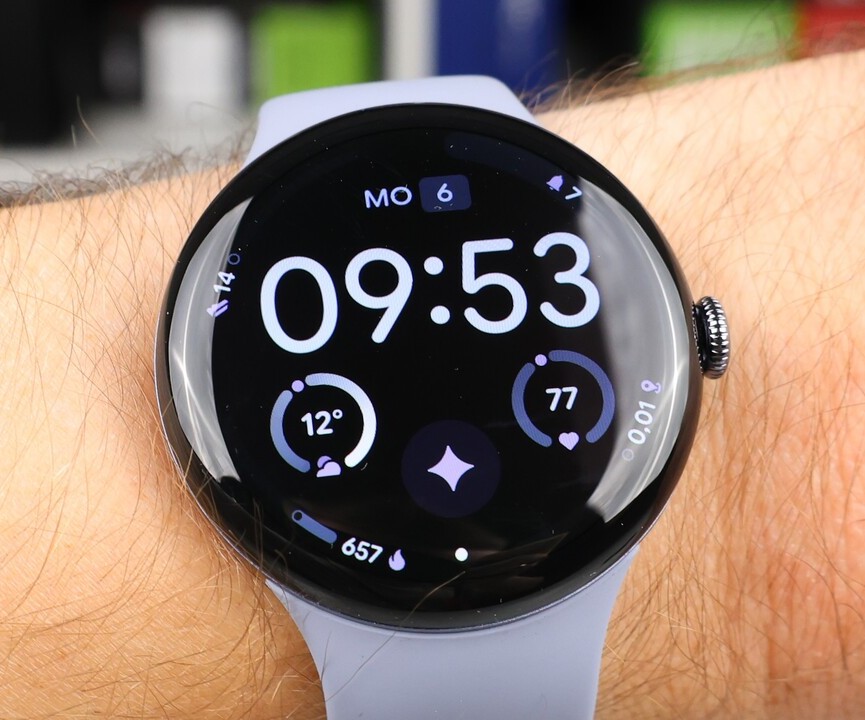
Ich verwende seit Jahren horizontale Handy Gürtelholster(*) von Matador, es gibt auch ein Modell mit zusätzlicher Reißverschlusstasche Brisbane (*). Screenprotektoren oder Handyhüllen brauche ich nicht. Ein Holster mag zwar uncool aussehen, genau wie die Chaskee Zuma Zip-In Cap(*) aber es funzt prima. Bei Unsicherheit wegen der Passform der Matador-Holster für ein bestimmtes Handy-Modell hilft eine Frage beim Händler schnell weiter. Ich bevorzuge die Version mit den Gürtelschlaufen, die mit dem Clip löst sich zu leicht vom Gürtel.
Zum Pixel 9a passt am besten das Gürtelholster Cellularline Tie Size Large. Dieses gibt es nur noch bei eBay, dafür aber für unglaubliche 3€.
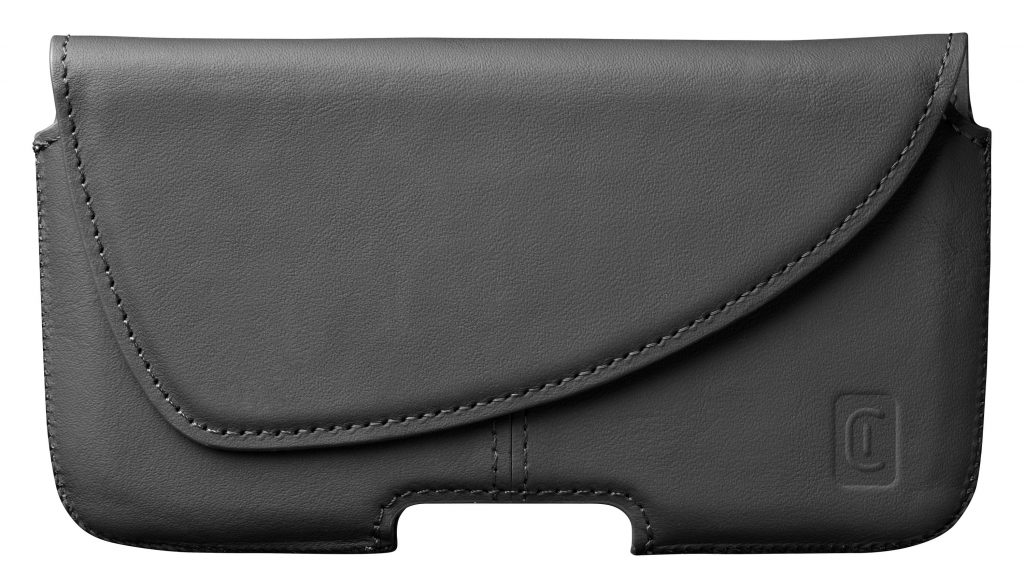
Ich mag die Samsung Galaxy Buds Live Earbuds(*). Diese sind halboffen, damit hört man seine Umwelt, und ich höre im Unterschied zu den dicht sitzenden Buds keinen Trittschall beim Gehen. Der Klang ist völlig OK. Verständlichkeit für Angerufene beim Telefonieren ist gut. Nach ein paar Min vergisst man, dass man sie trägt.
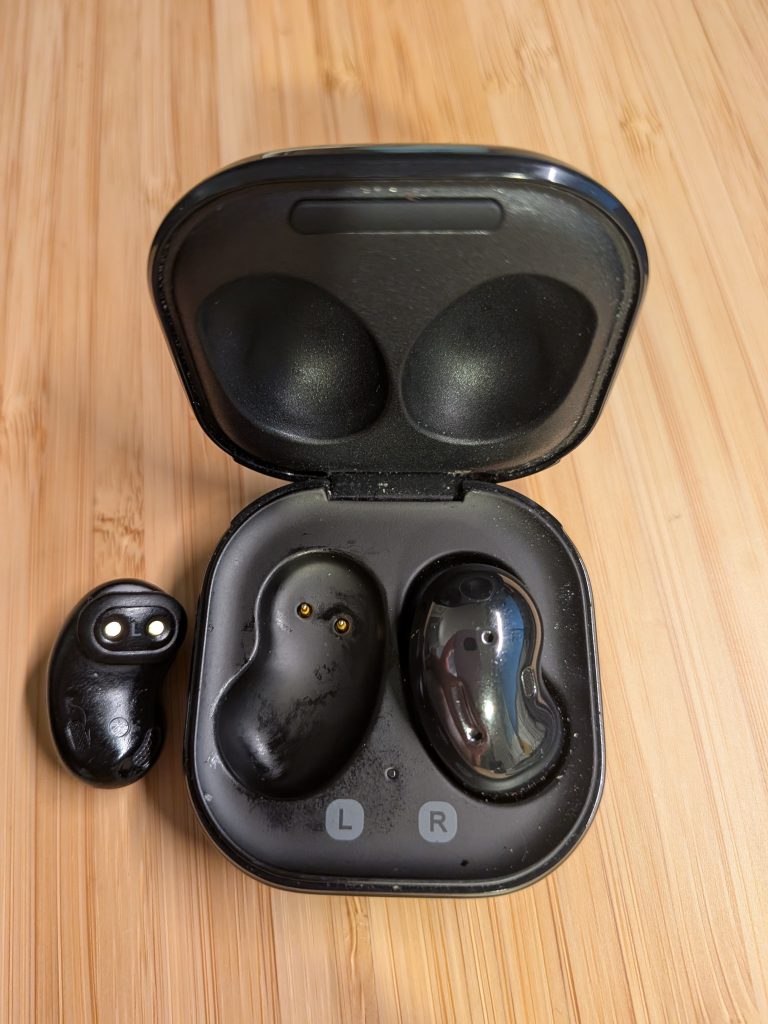
Von Perixx gibt es ein prima Kästchen für SIMs und SD Cards,damit man die Biester nicht verlegt.
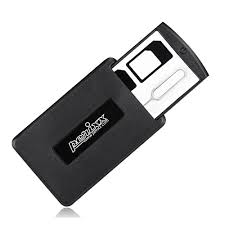
Manchmal ist ein Handy-Stativ wie das JOBY GripTight One (*) hilfreich.
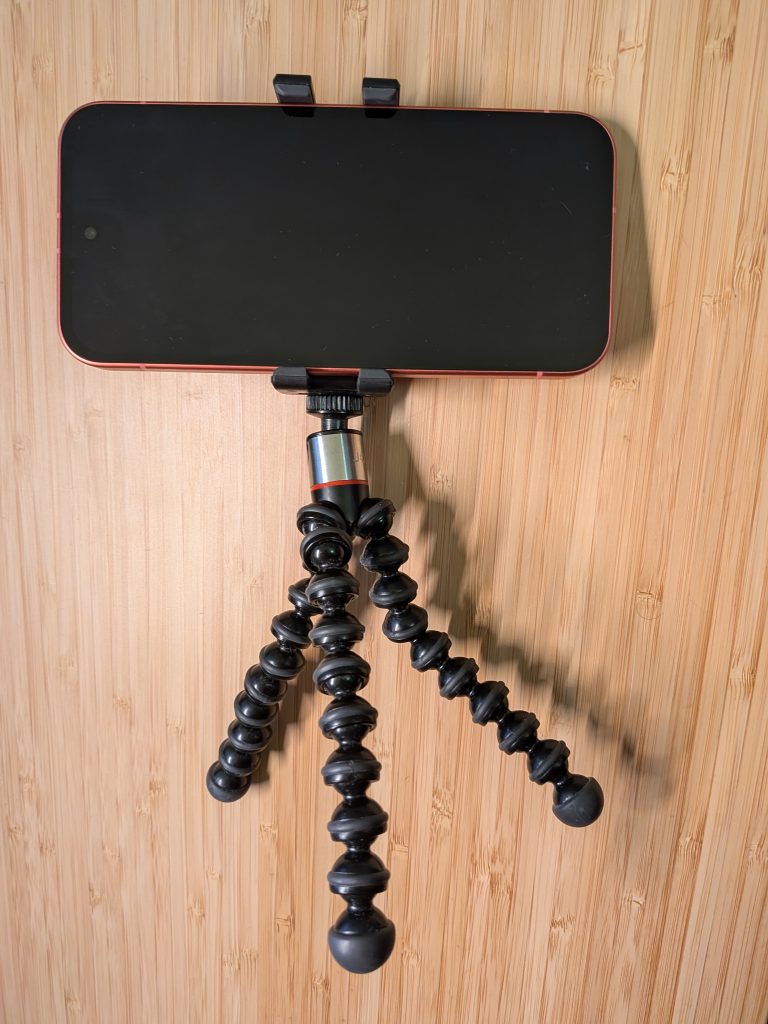
Prima Handy-Halterung für Autos (*) Hier für das für 9a passende im Mercedes A 160. Sieht wertig aus und ist stabil. Bei Unsicherheit, welche Version für welches Auto und Handy paßt: Über die Website des Herstellers Brodit oder per E-Mail info@brodit.de bekommt man zügig Auskunft. Es gibt auch Versionen mit USB-Steckern.

Von Peak Design gibt es jede Menge praktisches Handy-Zubehör:
Mobile | Peak Design Official Site
[ *) Dieser Post enthält Affiliate-Links. Das kostet dich nichts, bringt mir aber etwas Einkünfte.]
© 2025 Weltweit im Ruhestand
Theme von Anders Norén — Hoch ↑